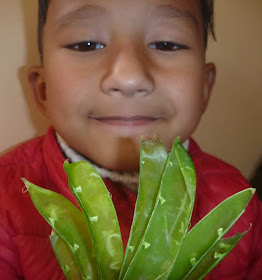The pea
Pisum sativum
Today, 23 February 2020. We are studying the pea which is a legume and eaten as a vegetable. It is a climber.
ORIGINS: The pea is believed to have originated in the Middle East, Mediterranean, and the Egyptian Nile area.
NUTRITION: The pea gives us a lot of Vitamin C along with fibre, Vitamin A and potassium among other good nutrition.
METHODOLOGY: We were paired with a friend and received a pod to etudie (as the French put it). Shila, Krit, Aarambha, Snigdha, Vidheha, Bishes, Shuvan, Mridvika, Aadhijay and Siddhant were involved in the study. After studying the pod, we opened it and observed what was inside. We measured and described the content. Then we proceeded to document the smell and taste of the plant.
POD: First we had to study to outside of the pod.
- The color of the pod was green, getting darker at the back.
- The shape was long and narrow.
- The length was 12.1 cm and the width 2 cm.
PEAS: After studying the pod, we opened it. Inside we saw spherical seeds that were light green. There were ten peas in my pod. Two on the top and bottom was very small with the other eight being big. The smallest peas were 3 mm and 4 mm in diameter. The largest pea was almost 9 mm in diameter. On one side the peas were a little white, especially with little connecting points where they were attached to the pod. The peas were not perfectly spherical. We saw that the seed broke up into two equal parts connected together by a skin. Therefore, the pea is a dicotyledonous seed.
SMELL: The peas smelled of green leaves but the smell was light.
TASTE: The small peas were a little sweet and bitter. The largest peas were sweet. Some did not have much taste.









No comments:
Post a Comment